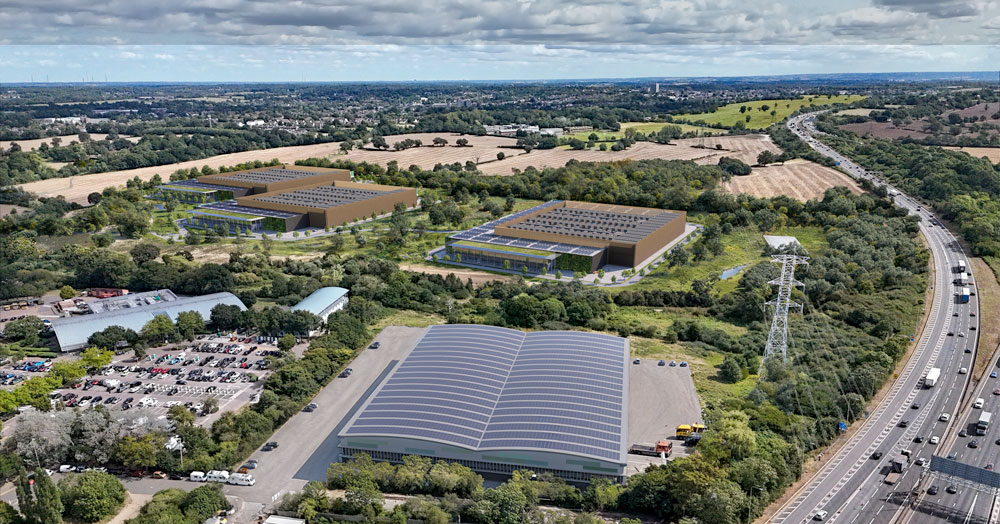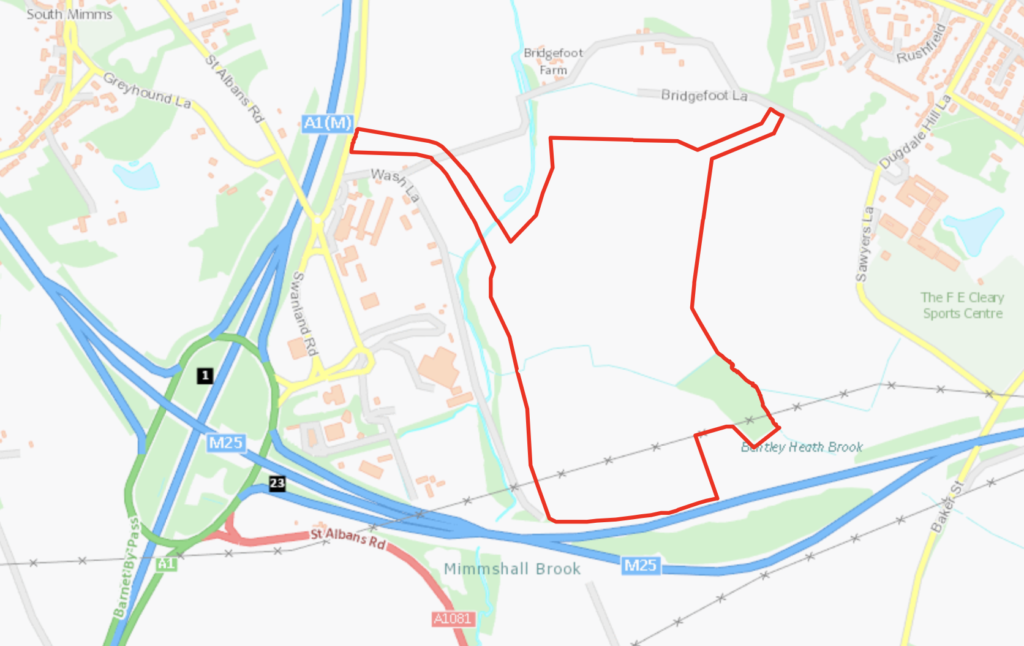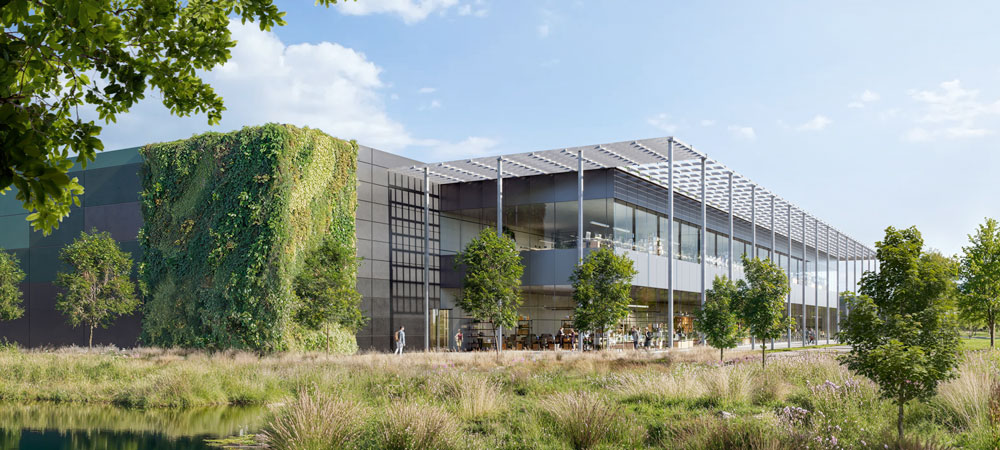Well, possibly. Data centres are the cotton mills and steel foundries of our day. Vast, industrial-scale facilities that are right at the heart of the fourth industrial revolution. And one might be built right here, next to the motorway in South Mimms.

We’ll admit to a certain childish excitement about this. Mysterious developers want to build Europe’s largest data centre right here in Hertsmere. The developer applied for planning permission in September of last year and last week the council granted outline permission for the development. We suspect they’re as excited as we are, although there’s some doubt as to how involved Hertsmere can now be, given the special status of this development. We’ll be keeping an eye on this project and we’ll provide as much detail as we can as it progresses but, to begin with, here’s what we know so far:
Are you serious? On the green belt? The data centre, if built, will be on green belt land to the East of South Mimms services, right next to the M25. The developers are in luck, though: this is exactly the kind of relatively-unloved green belt that the government has recently been calling ‘grey belt‘. You might expect a plan to build on 85 acres of agricultural land in a district that has a history of green belt belligerence to produce an angry reaction (like the one that held up the Radlett Railfreight terminal for years) but when even Peter Waine, chair of the Hertfordshire branch of the Campaign to Protect Rural England, speaking to the BBC, can’t muster more than: “It may not be the most wonderful and beautiful green belt but it is green belt…” Here at Radlett Wire, at the other end of Hertsmere, we get the strong feeling this particular chunk of green belt may not be long for this world.

It’s going to be huge. The claim, in the news stories and press releases, that DC01UK will be the largest data centre in Europe looks defensible. Europe’s largest running data centre is presently in Portugal. It covers about 800,000 square feet and the proposed South Mimms operation is aiming for two million square feet. But there’s another project, in Newport, Wales, that’s also aiming for two million and, anyway, the critical measurement – especially for the local community – is probably not square feet. Planners and architects use a measure they call gross external area (GEA), which is more useful. It’s the total area of a building, including all floors, measured from the outside. It’s the critical measurement used for rating, council tax and planning. DC01UK’s GEA is 187,000 square metres, slightly more than the 185,000 square metres (2,000,000 square feet) that will be devoted to computers. And as we’ll explain, there are other important numbers – relating to water and electricity use and to pollution – that we should understand and keep an eye on.
But size isn’t everything. If completed – and if not eclipsed by other projects along the way – this puts DC01UK just inside the top ten biggest data centres in the world, but it’s an extremely volatile market, and brutal and connected directly to the financial performance of the companies that use these facilities. Data centre capacity is a commodity – like bauxite or wheat. The biggest firms (Google, Amazon…) build and run their own but most data centre capacity is bought and sold by intermediaries or brokers. A business that needs servers for a new app is concerned only with cost; margins must be hair-thin, effiency constantly improving. So, honestly, how this plays out, between now and the proposed opening date in 2030 is anybody’s guess. Whatever happens, as you’d expect, this enormous facility is already well-and-truly dwarfed by the biggest. A single Chinese data centre, operated by China Telecom, is already over five times bigger than DC01UK and sits on a campus called the Inner Mongolia Information Park in Hohhot, China alongside several other enormous facilities (truly visible from space). Also, you probably won’t be surprised to learn that the seventh largest data centre in the world is buried in the side of a mountain in Utah and is operated by the United States National Security Agency. It’s safe to say that, although you’ve never heard of it, it knows a fair amount about you.

Who will own the data centre? Guess what: we don’t know. We know a bit about the company set up to see it through planning, DC01UK, but nothing about the facility’s final user nor even its ultimate owner. This project is, according to Computer Weekly, a joint venture with local house-builder Griggs and Chiltern Green Energy, neither of which – I hope they won’t mind me saying – are what you’d call giants of the information age. The Register, a UK tech news web site, says it will ultimately be used by one of the ‘hyperscalers’ (industry jargon for the handful of tech giants in a position to make use of such a huge facility) but that the usual suspects – Amazon, Google, Microsoft and Meta – all declined to comment. This is not surprising. The big firms are typically secretive about their data centres – these are, to state the obvious, business-critical, round-the-clock facilities and ‘uptime‘ must be protected at all costs. Amazon, in particular, treats its data centres as if they were national security assets and goes to great lengths to hide them. There’s only one project described on DC01UK’s web site and there’s no ‘about us’ page. We expect it’ll be some time before we know who the final client is.
There’s some history in this area. DC01UK was incorporated in 2022 and was originally called Hilfield Battery Storage so we assume it’s connected with the application to build a battery storage farm on Hilfield Farm in Aldenham, rejected last year after a public inquiry. One thing is clear: the deal-making has begun. Vast facilities like DC01UK don’t just show up in districts like ours – they’re incentivised to do so. Tax breaks, subsidies, promises about transport, housing and infrastructure, cut-throat competition between regions – all will play a part in this project. We don’t know enough about any of this yet – and the actors are secretive, but we suspect there will be people in Hertsmere who already know substantially more than us – we’d love to hear from you in the comments!
What’s so exciting about data centres? Aren’t they just big, dumb warehouses for information? Data centres have been a big deal for a long time, since the first of the really huge online businesses began to build their own all around the world. But the pressure to provide new data centre capacity has recently exploded (last year Goldman Sachs estimated a 160% increase in demand). It’s become a very big story in the business and technology press and now it’s crossed over into the mainstream media and social media – and it’s all because of artificial intelligence (AI). AI needs an enormous amount of computing power – both in training new models and in running queries against them once they’re live. Typing a query into ChatGPT will usually use at least ten times more computing power – and thus electricity – than a Google search. And the industry really didn’t see this coming. It’s really only a couple of years since it dawned on the tech firms and on their investors that they were going to need many times more computing power than previously projected. So the rush is on.
Governments and local authorities have noticed this massive new opportunity and are rushing at it. Three weeks ago Keir Starmer launched his AI action plan, which he says will ‘deliver a decade of national renewal’. We should probably also acknowledge the boldness of Hertsmere here. Council leader (and head of something called the Hertfordshire Growth Board) Jeremy Newmark has obviously moved quickly. Apart from the obvious explosive dynamism of the AI industry he’ll be aware that, here in Britain, the government has committed to a completely new and much more aggressive orientation on economic growth – and to change planning procedures to speed up development. More specifically, data centres have been reclassified as critical national infrastructure and will have special status when it comes to planning inquiries. In fact, developments recognised as nationally significant infrastructure projects have had special status since the then Labour government created the status in 2008. In this regime, the local authority is not the lead planning authority – just a ‘statutory consultee’. DC01UK may already be on the fast track.
But could anything hold it up? Short answer: yes. And it probably won’t be planning. Even in the couple of weeks since we learnt about the project, the terms of the explosion in data centre capacity have changed completely. Less than a week before Hertsmere’s DC01UK announcement a new Chinese-built AI model called Deepseek R1 was launched. To say that it caused an epic freak-out at every level of the AI ecology would not be an overstatement. The freak-out centred on the fact that this new software was almost as efficient as the leading American models although it had been built on simpler technology – and much more cheaply. It was a huge shock, challenging the fundamentals of the emerging industry. As it dawned on the company’s competitors that a rich and useful AI model could be built using a fraction of the resources, that their assumptions about the progress of the technology could be all wrong, share prices tumbled, projects were cancelled or paused, projections and forecasts altered. So, could this global chaos change the trajectory of the South Mimms project? Cause it to be cancelled or scaled back? It really could. At Hertsmere Council everyone will have their fingers crossed.
In the next post, more about the crazy business of powering (and cooling) a modern data centre.
- For comparison, the largest warehouse in the UK – belonging to Amazon.com, natch – also covers around two million square feet. The O2 covers 1,126,270 square feet.
- It took the addtion of the magical term ‘AI’ to give all this stuff the kind of political salience it needed. When Technology Secretary Peter Kyle announced the change in status for data centres in September the most exciting application he could come up with for these gigantic buildings was storage: “…from photos taken on smartphones to patients’ NHS records and sensitive financial investment information.” Boring! In the few months since then, the AI brainworm has fully infected everyone involved. When Rachel Reeves announced her big ‘growth reset’ in January it was all AI, all the time.
- Amazon’s policy of secrecy about the location of their data centres even extends to their own staff. According to Peter Judge in Data Center Dynamics: “Only those within Amazon who have a legitimate business need to have such information know the actual location of these data centers…”
- There’s another huge data centre under construction in Hertfordshire – Google is building the company’s first UK facility in Waltham Cross. Incidentally, the existence of this project may suggest that Google is unlikely to be DC01UK’s ultimate customer.
- Everyone involved with this project is obviously moving quickly. If the government’s promises about removing barriers to growth are real, this project could almost be a kind of benchmark. The completion date in the press release is a bit unimpressive, though. 2030? Elon Musk claims to have built his new Colossus AI data centre in 19 days (although he did basically just stuff 100,000 NVidia GPUs into an old washing machine factory).
- Bookmark this page to keep up with our updates on DC01UK. If you’re one of those weirdos who still uses an RSS reader, follow our feed or this Google news alert (RSS explained). We’ll almost certainly be tweeting about this of course.












































